While formula and bottle feeding can be real life saviors for some parents, it can come with it’s challanges. The bottles can be a real pain to clean, and feeding formula requires some thought too. Not to mention organizing all the bottles and sterilizing when on the go – I have done it and, believe me, it wasn’t always easy!
But there are a lot of formula and bottle feeding tips or hacks that can make parents’ life so much easier. And I have gathered them all here for you!
Below you will find everything you need to know to make bottle feeding as easy as possible. Including bottle feeding tips for when you are on the go or for nighttime. Don’t worry, I got it all covered!
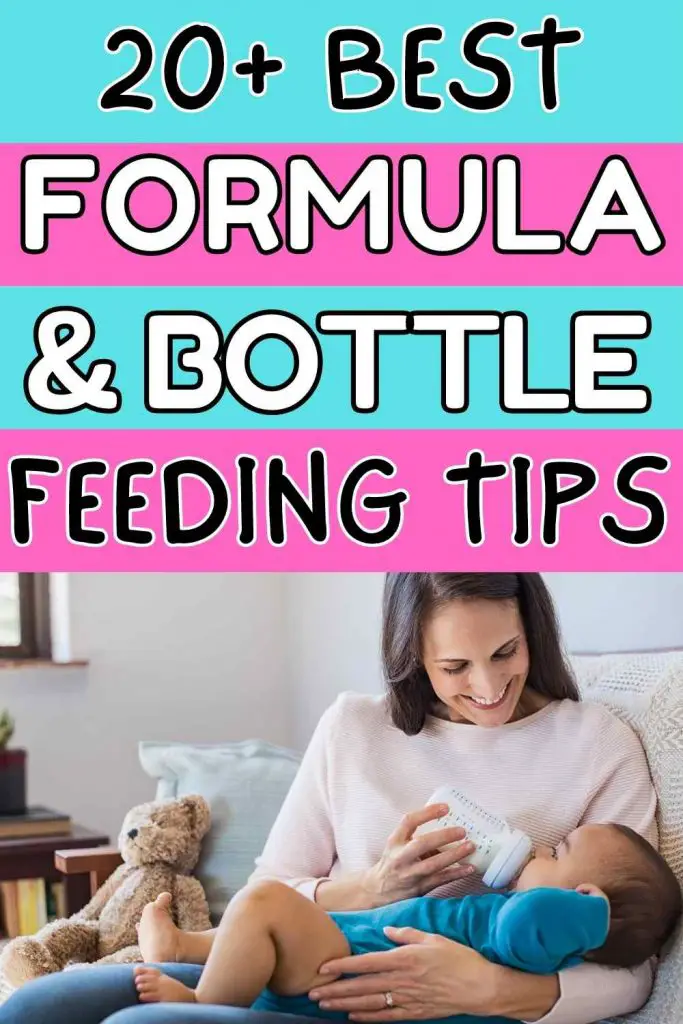
My Personal Formula Feeding Experience
My wife and I weren’t really planning on bottle feeding our babies. Not that we had anything against it, but we just thought it would be more practical and cost saving to breastfeed. Turned out life had other plans for us 🙂
When my wife gave birth to our first daughter she was unable to breastfeed, and we quickly had to turn to bottle feeding for our little one. I remember rushing with my mom through shops trying to buy everything we needed for bottle feeding: the bottles, the bottle warmer, the formula, sterilizing tablets … I felt so overwhelmed!
We had done ZERO research on bottle feeding, so it was a big thing for us to learn and get used to.
But almost 3 years went by during which we formula fed our first baby anywhere possible: from the car, to tramping tracks, to airports and airplanes, boats, beaches, and so on. We got used to formula feeding at night with as little disruptions as possible to our daughter, we learnt about paced bottle feeding, and I really feel like we nailed the cleaning of the bottles.
I have also pumped and bottle fed (with breast milk) my second daughter a few times, even though she was manly breastfed.
So, whether you are formula feeding in between breastfeeding, or formula feeding exclusively, or you are pumping and bottle feeding with breastmilk, I am confident you will find all the tips for formula feeding and bottle feeding here 🙂
Related: Paced Bottle Feeding – Benefits and Tips on How to do it right
Things to know before you start Formula Feeding
Before I go through my tips for bottle feeding, there’s a couple of important things that you should be aware of when feeding your child formula.
1. How often should a formula fed baby feed?
If you are a first time mom with a newborn, you are probably wondering or worrying about how much and how often you should be feeding your baby.
While the rule of thumb with a newborn is to follow their hunger cues and feed them on demand, it’s also true that, for a first time mom, understanding when your baby is hungry or tired or just wants to be held in your arms can be a bit tricky. I remember we were panicking sometimes because we had no idea why our child was crying!
There are some guidelines that you can follow to make sure that you are giving your baby enough formula. Plus formula tins usually have instructions on how much to feed your baby depending on their age.
As a general guide:
- Newborn: about 1-3 oz (30–90 mL) every 3-4 hours.
- 2-4 months: about 4-6 oz (120-180 mL) every 4-5 hours.
- 6 months: about 6-8 oz (180-230 mL) every 4-6 hours.
And – hey! – if it makes you feel any better, the good thing about formula feeding is that you known exactly how much your baby is taking in, and you don’t have to worry about them not having enough milk! Which happened to me when breastfeeding our second daughter … but that’s another story 🙂
If you want to keep track of your baby’s weight to make sure they are feeding enough, also check out this post on how to weigh your baby at home!
2. At what temperature should formula be?
According to the CDC (Centers for Diseases Control and Prevention), formula does not need to be warmed before feeding. However, some people like to warm their baby’s bottle, and some babies also seem to have a preference, refusing the bottle if the formula or milk are too warm or too cold for their liking.
We personally were never given a choice: we were told to warm the milk before giving it to our daughter and we never questioned it. So, lots of tips in here are going to be about how to warm the milk.
However, if you decide to give your baby room-temperature formula, that could also be a tip to speed things up and make it easier 🙂
To test that the formula is at the perfect temperature, place a few drops of milk on your inner wrist. It should feel warm: not too hot nor too cold.

Formula Feeding Tips & Hacks
Without further ado, here’s a list of the best formula feeding tips and hacks for new moms! These tips are exclusive for formula feeding so, if you are pumping and feeding your child breastmilk in the bottle, you might want to skip to the next paragraph on general bottle feeding tips 🙂
1) Find the Right Formula for your Baby
No formula is the same! There are different types of formula: from cow milk, soy, goat milk, organic formula, etc. And even amongst the same type of formula, the different brands vary.
Your baby is unique and will react differently to the different formulas. We ended up switching from cow milk-based formula to goat milk-based formula under recommendation from an homeopath, to try and reduce the amount of mucus she always had in her nose. And when we went to Italy for a month to visit my family we had to try a couple of different types from over there before we could find one that wasn’t giving her very bad diarrhea.
Make sure you find the right formula for your baby, then stick to it. If your baby doesn’t like the first one you bought and is refusing the bottle, maybe try a different one. However, make sure not to switch too quickly: give your baby time to adjust to the new formula. Most pediatricians recommend staying with a formula for at least one week instead of switching too frequently, which can cause digestive issues for baby.
Check this article for signs that you should be switching formula.
2) Don’t get too Hung Up on Quantities
Even though there are guidelines that you can follow with regards to the amount of formula that you should be feeding your baby, remember these are just guidelines!
One mistake we did when our first daughter was not realizing that she was still hungry after we were giving her the bottle. We were giving her the exact amount that was written on the formula tin, but she obviously needed more. She was so upset after the bottle and took us a while to realize she just wanted a bit more!
Don’t be too strict, follow the hunger cues and remember that your baby knows what they needs 🙂
I wouldn’t worry too much about your baby having too much or not enough formula unless your baby is starting to loose too much wait. And if you are worried for any reason, don’t hesitate to contact your pediatrician.
3) Use a Formula Mixer
Isn’t it annoying to open the tin of formula, measure the water, measure the formula and shake the bottle every time? What if you could prepare a big jar of formula in the morning, and pour it in your baby’s bottle throughout the day and night?
Well, a formula mixer does just that! Do it in the morning and forget about it till the next day. Just remember that pre-mixed formula that’s stored in the fridge is only good for 24 hours, after which you have to discard it.
Don’t leave the formula at room temperature: that only lasts for a couple of hours before you should be throwing it away.
Related: How to Store Formula Milk for Night Feeds (6 Solutions to Fit your Needs!)
4) Get a Formula Dispenser Machine
I so wish I knew about this one when I had my daughter who was bottle-fed! A Formula Dispenser Machine / Formula Maker is an amazing gadget that will automatically mix and dispense the formula for you at the press of a button.
It allows you to set the formula concentration, temperature and milk volume. Plus, because the water is kept warm (for up to 24h), it will dispense the formula in the bottle immediately – no more waiting for the milk to warm up. How useful and easy is that?!
Bottle Feeding Tips & Hacks
Here’s a list of baby bottle feeding tips to make bottle feeding a breeze for new moms, whether you are formula feeding or feeding your child breastmilk! These are perfect baby feeding hacks if you are planning on bottle feeding from the very start, but also incredibly useful if you started with breastfeeding, and now are looking at moving from breastfeeding to bottle feeding 🙂
If you are struggling with breastfeeding and/or need help with pumping, also make sure to check out these Online Breastfeeding Courses, including FREE Courses!
1) Pay Attention to the Nipples
Believe it or not, there are different types of teats / nipples for bottles. Teats have got little holes on top that let the milk out, and the number of holes vary: the more or the bigger the holes, the stronger the flow. I was honestly so clueless about this when we started formula feeding our baby.
For a newborn, you might want to try a slower flow first, and see if your baby is happy with it or gets frustrated because not enough milk is coming out. As your baby grows, you’ll find that you can change the teats to a faster flow.
With our daughter we made the mistake of starting with quite a fast flow and she was struggling to keep up: there was milk dribbling down everywhere. That also made her inhale lots of air, so we had to spend quite a long time burping her. Changing to a slower flow made a huge difference and she was much happier.
Some babies are quite happy to stay on the slower flow, others will start getting frustrated and refusing the bottle because milk is not coming fast enough (yep, me!). Always remember to follow their cues to see if it’s time to upgrade to different teats.
2) Use a Bottle Warmer
If you are like us and you like to warm the formula or the breastmilk, do yourself a favor and buy a bottle warmer 🙂
We found it was too stressful to boil some water, stick the bottle in and constantly check if it was warm enough or not. And I used to hate when I left it in the hot water for slightly too long and now the milk was too hot. Meanwhile my baby was screaming for food!
In case you don’t have a baby yet and don’t know, babies go from zero (being super calm) to 100 (crying historically because they are hungry) in like 5 seconds. You have to be super quick at catching their hunger cues, otherwise good luck! And if you don’t have the luxury of just sticking out a boob, it can be a bit stressful.
The great thing about a bottle warmer is that you know exactly for how long you should leave it in there depending on the amount of formula that’s in the bottle. If you have a mind that works like mine, you will love how precise and scientific it is 🙂
We personally used the Philips Avent Baby Bottle Warmer and was very happy with it. We actually bought two, one for our home in New Zealand and one for when we were on holiday in Italy.
3) Use a Microwave Sterilizer
This is one of my favorite bottle feeding hacks!
I hear of so many people rinsing their bottles and then putting them in the dishwasher, without sterilizing them. And, while many doctors are saying there is no longer a need to sterilize bottles if your water is safe to drink, many pediatricians are still encouraging sterilizing due to contaminated city water supplies.
We were personally told to sterilize the bottles and teats, so that’s what we did. And what’s great about sterilizing your bottles is that you can skip the dishwasher really. Bottles can take up so much space in your dishwasher, plus you need to make sure you have enough bottles to get you through the day, as you don’t want to start it every time your baby has a feed.
Whereas if you are sterilizing the bottles, just give them a good scrub with soapy water and that’s it, they are ready to be sterilized. And the best, quickest, most genius way to sterilize the bottle is a microwave sterilizer!
Microwave sterilization uses hot steam from water to sterilize baby bottles and teats. It literally takes 2-3 minutes in the microwave and they are ready to go. We were gifted the Philips Avent Microwave Steam Sterilizer and, honestly, it was amazing. We also used it to sterilize my daughter’s pacifiers.
FYI: before we started using the microwave sterilizer, we used to use sterilizing tablets (that’s also what we were given from the hospital), and it was so annoying having a container with water sitting on the kitchen counter the whole time, with bottles in it waiting to be ready.
4) Use a Dishwasher Rack
If you are more of the opinion that you don’t need to sterilize your bottles and you want to stick to using the dishwasher machine, consider buying a Dishwashing Basket for Bottles. This is perfect to keep your bottles into place all together and not loose any teat.
5) Sit your Baby Upright

Try feeding your baby while they are sitting on your lap, so they are in a more upright position, and keep the bottle horizontal. Particularly if your baby is suffering from acid reflux or painful gas.
We did struggle with a lot of trapped gas with our daughter at the beginning, because she was gulping when feeding. Then our midwife suggested paced bottle feeding. That was one of the best bottle feeding tips we got really made a difference.
This method of feeding mimics breastfeeding and involves keeping your baby in a upright position and the bottle more horizontal. This helps slow down the flow, so that they don’t swallow too much air, and helps keeping the milk in their stomach.
6) Burp your Baby Frequently
Bottle-fed babies tend to drink faster than breastfed babies, so they are more prone to swallowing air while feeding. For this reason, burp them frequently to get rid of any trapped gas!
We found that it gets a bit harder when babies have a blocked nose: they can’t breathe properly, so they end up swallowing more air when feeding. Be patient if your baby has a cold and give them many opportunity to burp and release that air.
If you are not too sue whether your baby has trapped gas or not, check out these symptoms of trapped gas in infants.
7) Use Bibs with a Plastic Underlay
Formula stinks and you really don’t want too much of it on clothes. And I guess the same goes for breastmilk.
Our daughter used to dribble everywhere and, even using bibs, we used to have to change her top after almost every feed. Most tops ended up having stain from formula around the neck!
What we found to really help was using bibs that have a waterproof layer, either in the middle or at the back. Make sure the top layer is still made of an absorbent material like cotton, so that the milk doesn’t drip down across the bib and onto the clothes.
The only disadvantage is that the waterproof layer doesn’t last forever. It tends to crack after a few months, so we ended up buying about three different batches within 2 years of bottle feeding.
As a general rule, stock up on lots of bibs and burp cloths, you’ll need them!
8) Use a Brush with a Nipple Cleaner
You definitely need to buy a bottle brush to make sure you get to clean all the formula or breast milk from the bottle. But make sure you buy one with a nipple cleaner as well.
The nipple of the bottle is quite tiny and difficult to clean properly with a big brush. The nipple cleaner is perfect to get in there.
9) Have a Back Up to get Hot Water
Okay, I get it, this one might sound odd an overly pessimistic, but have you ever though what you would do to warm the formula or breastmilk up if you run out of electricity (and you have an electric stove, obviously)? Or what if you need to boil the water first because you don’t have access to clean water from your tap? I mean, it happens, right?!
Well, it happened to us. Twice! The first time we kind of panicked a little bit, but then we realized we could use the barbecue outside to boil some water in a pot. After that time, we always made sure we had enough gas in the barbecue bottle!
And don’t think that you can just run to a bar or café for some hot water. If the whole block doesn’t have electricity, then the café down the road is probably in the same boat.
If you don’t have a barbecue, maybe consider a small portable camping stove.
10) Wash as you go
Make sure to wash the bottles as you go: don’t leave them in the sink the whole day. If you do, you will end up scrubbing out crusty nipples and stinky bottles.
I used to rinse the bottles throughout the day and leave them upside down on the microwave sterilizer. When that was full, I would sterilize them and … boom, done!
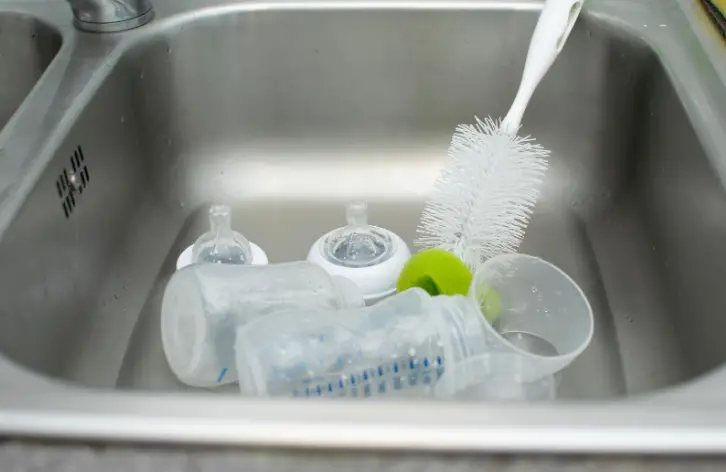
11) Use a Bottle Holder
Encourage independence and let your child hold the bottle. Trust me, I think you will enjoy leaving your baby on the baby bouncer feeding themselves, while you continue with your chores.
However, holding a whole bottle can be hard for your little one’s tiny fingers. So, you can try a bottle holder that has smaller grips for your baby to hold it easily. It usually works for babies from around 3 / 6 months of age.
Bottle Feeding at Night Tips
Who here thinks that night feeding is torture? Yip, raise your hand … I can see you all agreeing with me 🙂
Some nights, when baby is teething or sick, they wake up so many times and all they want is extra feeding. I know the sucking from the bottle or boob helps them, but it’s excruciating!
So, here’s my best tips for bottle and formula feeding at night to survive the night with a baby. You can also check here some tips on how to store formula milk for night feeds, or how to keep a baby bottle warm at night.
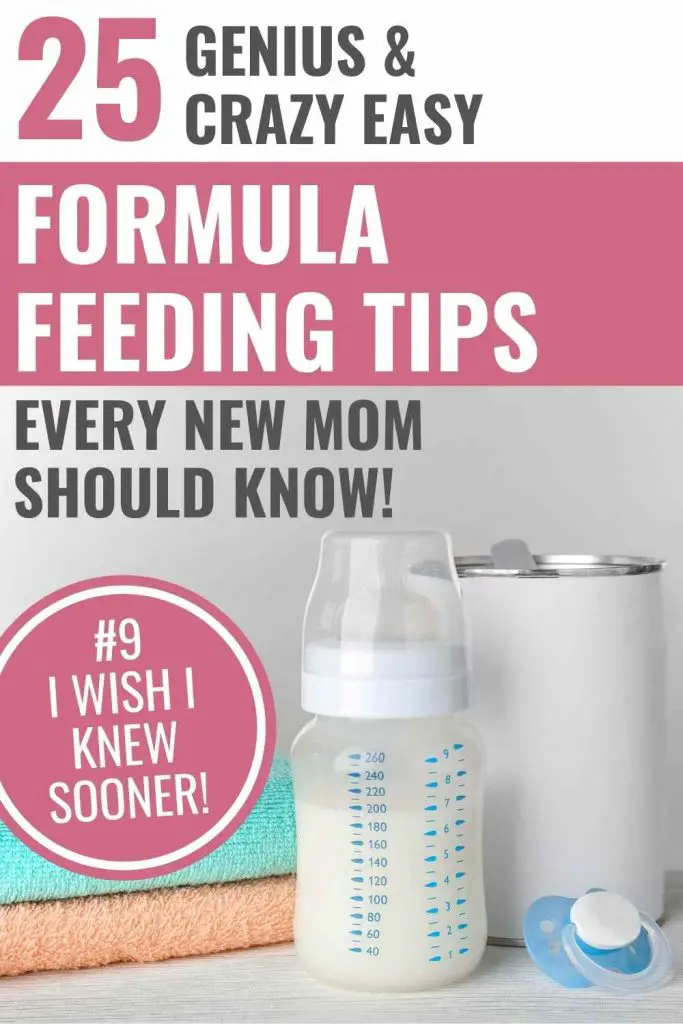
1) Take Turns with your Partner
Mama, you got the biggest advantage of all compared to moms that choose to breastfeed exclusively: you can share with your partner! So, one of the best tips for formula feeding at night is to get them involved with the night feeds please.
While my wife was still on maternity leave, she used to do all nights Monday to Friday. I will then do the weekends. Once she went back to work and we were both getting up early to go to the office, we would alternate every night.
I used to use earplugs the nights I was not feeding … Those were good nights sleep 🙂 Now that we have two, both waking up at night, there is no escape.
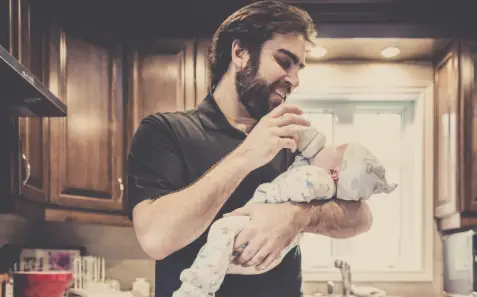
2) Prepare your Bottles Before going to Bed
If you are not already using a formula mixer and preparing it in bulk in the morning for the next 24 hours, at least make sure you prepare your bottles for the night before going to bed. You can then have a look at different ways that you can store formula milk for night feeds here.
There is nothing worse than getting up in the middle of the night to feed your baby, and you need to turn the light on to still prepare the bottle. First of all, all that light will wake you (and baby) up even more and it will be harder to fall back to sleep. Second of all, it will take you longer, and the chances of your baby really getting upset because food is not coming yet increase drastically.
3) Do not change the Diaper at Night
This is not just a bottle feeding tip: it also applies to moms that breastfeed. But honestly, do not change your baby’s diaper at night. Buy some diapers that will last longer through the night if you have to.
Changing your baby’s diaper will highly increase your chances of them waking up completely, and then you will spend the next two hours trying to settle them back to sleep.
We use cloth diapers and we used a different type of cloth diaper at night to make sure it would last 12-13 hours in a row.
Related: The Ultimate Guide to Reusable Diapers
4) Use a Dimmed Light
Whether you need to turn the light on in the kitchen to make the bottles, or in the room while you are feeding baby, I would recommend using a dimmed light. Again, this will help your baby not to wake up completely.
While you might think that this is also a breastfeeding tip, I found that with breastfeeding at night I didn’t really need to turn the light on: I could do anything in the dark. Whereas with bottles it was a bit harder: I had to see where I was putting the bottle lid and make sure I was putting the bottle nipple in my daughter’s mouth and not her forehead.
We personally use a Himalayan salt lamp, which has a beautiful dimmed pink light. Or you can buy a baby dimmer light.
5) Use a Bottle Warmer with a Cooler
A Bottle Warmer with Cooler is another great gadget that keeps up to 2 bottles cool at night (for up to 8 hours), without having to keep them in the fridge, and it also includes a warmer. While you will still have to wait for it to warm the bottle, at least you don’t have to walk all the way to the fridge to get one.
6) Use a Thermos or a Portable Bottle Warmer
A Portable Baby Bottle Warmer is a perfect hack to keep the water for the bottle warm at night. Pour in hot water before going to bed and it should be at the perfect temperature when baby wakes up for a feed.
Just make sure to always check the temperature of the water before mixing the formula in. It should feel warm: not too hot nor too cold. Because depending on what time your baby wakes up after you’ve placed the water in the bottle, you might need to add a bit of cold water to cool it down.
The great thing about a Portable Baby Bottle Warmer is that you can also take it with you when going outside with your baby. In fact, it’s one of my best tips for warming the bottle when on the go below.
7) Use a Water Kettle that keeps Water at the Right Temperature
Can you believe there are kettles that keep the water at a constant temperature?? These are perfect for the water for the bottles: you can leave the kettle on the whole night and, not matter what time baby wakes up, the water will be already ready at the perfect temperature to be mixed with the formula.
The Baby Formula Water Kettle below only takes 30 seconds for the water to reach the desired temperature, so you could even use it during the day to prepare a bottle in record time. It has a capacity of 1.2L and turns off automatically when it runs out of water.
8) Use a Crockpot for Warm Water
Don’t you want to spend money for a bottle warmer but you do you have a crock pot? Then just put water in your crockpot before going to bed and leave it on low at night, so that you can warm bottles up quickly during the night.
This is one of my best tips on how to warm baby bottles up quickly at night. And the actual advantage compared to a normal bottle warmer is that you can leave it on the whole night, so that the water will be already at the perfect temperature when you need to put the bottle in. With a bottle warmer, instead, you need to wait for it to warm the water up first, plus you cannot leave it on the whole night.
Tips for Bottle Feeding on the Go
We are a family always on the go. Whether it’s going on a tramping trip, biking, at the park or wherever: 90% of the times you will find us outside. So we really had to get organized to bottle feed our daughter while outside.
Not to mention we flew twice within the first 18 months of her life from New Zealand to Italy and back. More than 30 hours in a raw away from home: that really made us think outside the box!
Here’s the best bottle formula feeding travel tips we came up with!
1) Find the Perfect Balance of Hot and Room Temperature Water
If you prefer to feed your baby warm formula, then you might find it a bit hard to warm it when outside. The best hack we came up with was to find the perfect balance of hot / boiling and room temperature water, so that by mixing the two with formula we would instantly get milk at the perfect temperature.
We knew exactly what the two quantities to mix were. We would just ask for some boiling water at a cafe and that was it. Obviously we had to adjust the quantities as our daughter grew and she was drinking more milk.
EXTRA TIP: don’t be shy to ask for boiling water in cafes, bars or restaurants. People are extremely understanding and will gladly make you a favor. We went through I don’t know how may restaurants at the airports asking for boiling water, and nobody ever turned us away. Except from a lady working at Starbucks at the Vienna airport: what a bitch!
When flying, you can ask the flying attendants for some boiling water.
2) Use a Portable Baby Bottle Warmer
Not keen on mixing boiling and room temperature water? Here’s another formula feeding tip: use a Portable Baby Bottle Warmer. This will store your warm water from home while you are on the go.
So, you can actually use a portably bottle warmer both at night and when going outside!
We used to bring one of this with us when going to the beach with our daughter in Italy.
Related:
– 25+ Baby Beach Essentials (all the Gear you Need!)
– Baby at the Beach (30 Tips & Hacks to enjoy the Vacation!)
3) Use a Formula Dispenser
One of the best tips for formula feeding for when out and about is to use a Formula Dispenser. You really don’t want to take a whole tin of formula with you and measure the amount of formula to go in the water every time.
A formula dispenser allows you to have the exact amount of formula you need for a just a few feeds while you are out. The dispenser usually has a few compartments that you can open one at the time for when baby is ready to feed.
4) Always Take Extra Formula
Don’t risk it and just take the minimum amount. What if you drop some formula? Or what if you end up staying outside for longer than you had anticipated? Always take extra in your formula dispenser and be ready for any eventuality.
We once got stuck mid-way home on the motorway because the car stopped working. We had to stay in the car for about an hour, waiting for someone to pick us up. Thank god we had that extra formula with us,
5) Use Sterilizing Tabs to Clean the Bottles
If you are not home and you want to sterilize your bottle, you probably don’t want to take the whole microwave sterilizer with you! We used to take some Milton Sterilizing Tablets with us (but other brands will work too).
All you need to do is drop the tablets in a tub with some clean water and wait for it to dissolve. Then put the bottle and the nipple in it: it will be ready in about 15 minutes. You can keep using that same water for the next 24 hours.
We used sterilizing tablets the whole time we were in Italy, because we didn’t want to take the microwave sterilizer on the plane with us, plus my parents don’t have a microwave!
6) Use a Travel Sterilizer
When you are on the go, you also might not have a tub with you to pour water in for your sterilizing tablets. So, when we flew on the plane, we took a Travel Sterilizer with us. It’s tall, perfect size for formula bottles, so that you can sterilize them with the tablets wherever you are.
7) Use Boiling Water to Sterilize
The last of the tips for bottle feeding on the go: use boiling water to sterilize! This is actually also one of my best tips when traveling or flying with a breast pump.
I wouldn’t recommend this on a daily basis, but there may be times when you are away from home for a long time and you don’t have access to sterilizing tablets or a sterilizing tub.
When we traveled to Italy the second time and our daughter was still bottle feeding, we actually didn’t have any space for the travel sterilizer, so we used boiling water to quickly sterilize the bottles in between feedings. The flight attendants have access to it on the plane, and they were kind enough to give us some.
Bottle Feeding Tips for Twins
If you are bottle feeding twins, there are other tips that you can look into to make life easier. I personally don’t have twins, so I am probably not the best person to give advice on the matter 🙂
However, you can head over to this great article on Time Saving Hacks For Bottle Feeding Twins by Caitlin from Twin Mom 🙂
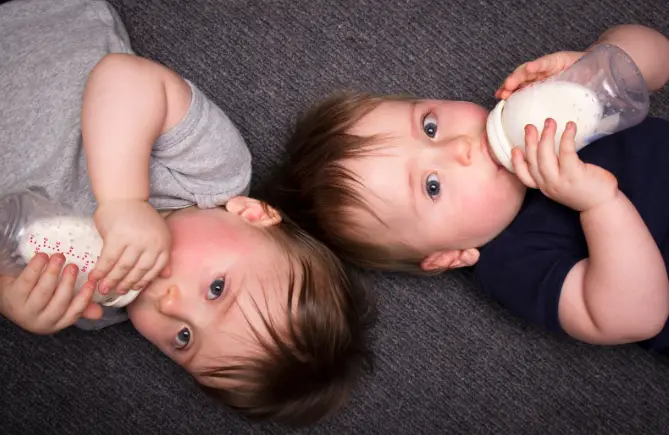
Formula & Bottle Feeding Tips: Final Thoughts
Before you know it, your cute little baby will start eating solids and those intimate times of cradling them in your arms to feed them will be a distant memory. So, enjoy these precious moments, even if bottle feeding can feel hard and overwhelming at times. And I really hope these formula and bottle feeding tips will help you make feeding your baby as easy as possible.
If your baby looks unhappy when being bottle-fed, don’t forget to also check out this article on Paced Bottle Feeding. Whereas if you are struggling with pumping, have a look at these online breastfeeding and pumping courses, including FREE courses.
For more tips and information on bottle and formula feeding, or just feeding baby in general, here’s some related posts:
- Baby Suddenly Refusing Bottle (Why & 19 Things to Try!)
- 5 Best Tips on How to keep Baby Bottle Warm at Night
- How to Store Formula Milk for Night Feeds (6 Solutions to Fit your Needs!)
- Sudden Drop in Milk Supply (Signs, Causes & How to Fix it!)
- How to Stop Breastfeeding a 1 Year Old at Night
- 14 Drinks that Increase Milk Supply
- 8 Tips for Flying and Traveling with Breast Milk and a Breast Pump
Are you bottle feeding your baby and have other questions that are not answered here? Or are you a mom of a bottle fed baby and you came across other tips that are not listed above? Then please let me know in the comments below – I’d love to hear from you!
Did you find this useful? Pin It!
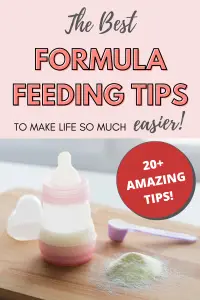



Great tips! I used a lot of these with my kiddos.
Thanks Brooke 🙂
Thank you for the valuable information. Can be so tricky sometimes.
I wish I had this when I was formula feeding this is so helpful!
Very informative, and in-depth article. Thank you. I shall surely follow you for my New born.
Thank you 🙂
I bottle fed/formula fed my daughter and used a lot of these tips myself and they made it so much easier! This article will definitely help someone preparing for bottle feeding.
Thanks for the feedback Jessica 🙂
I totally agree. Burping your baby frequently can make such a huge difference. It helps avoid too many spit-ups in babies. Thanks for sharing these tips!
Thanks for reading these formula feeding tips and for the feedback Melanie 🙂